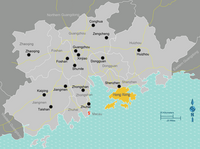
Photo from wikipedia
Background The results of the latest national survey on important human parasitic diseases in 2015–2016 showed Guangdong Province is still a moderately endemic area, with the weighted prevalence of soil-transmitted… Click to show full abstract
Background The results of the latest national survey on important human parasitic diseases in 2015–2016 showed Guangdong Province is still a moderately endemic area, with the weighted prevalence of soil-transmitted helminths (STHs) higher than the national average. High-resolution age- and gender-specific spatial-temporal risk maps can support the prevention and control of STHs, but not yet available in Guangdong. Methodology Georeferenced age- and gender-specific disease data of STH infections in Guangdong Province was derived from three national surveys on important human parasitic diseases, conducted in 1988–1992, 2002–2003, and 2015–2016, respectively. Potential influencing factors (e.g., environmental and socioeconomic factors) were collected from open-access databases. Bayesian geostatistical models were developed to analyze the above data, based on which, high-resolution maps depicting the STH infection risk were produced in the three survey years in Guangdong Province. Principal findings There were 120, 31, 71 survey locations in the first, second, and third national survey in Guangdong, respectively. The overall population-weighted prevalence of STH infections decreased significantly over time, from 68.66% (95% Bayesian credible interval, BCI: 64.51–73.06%) in 1988–1992 to 0.97% (95% BCI: 0.69–1.49%) in 2015–2016. In 2015–2016, only low to moderate infection risk were found across Guangdong, with hookworm becoming the dominant species. Areas with relatively higher risk (>5%) were mostly distributed in the western region. Females had higher infection risk of STHs than males. The infection risk of A. lumbricoides and T. trichiura were higher in children, while middle-aged and elderly people had higher infection risk of hookworm. Precipitation, elevation, land cover, and human influence index (HII) were significantly related with STH infection risk. Conclusions/Significance We produced the high-resolution, age- and gender-specific risk maps of STH infections in the three national survey periods across nearly 30 years in Guangdong Province, which can provide important information assisting the control and prevention strategies.
Journal Title: PLoS Neglected Tropical Diseases
Year Published: 2022
Link to full text (if available)
Share on Social Media: Sign Up to like & get
recommendations!